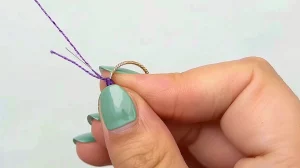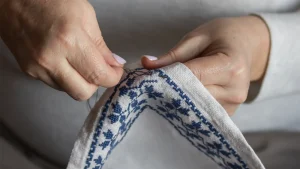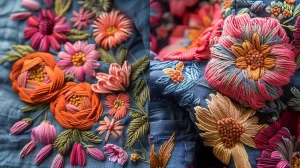Yes, you can embroider on fleece. Choose a high-quality fleece for a stable base. Pick simple designs and consider using a knockdown stitch for smoothness. Each type of fleece— from cotton to Sherpa—offers unique characteristics and possibilities, so choose wisely. Choose the correct stabilizer for support. And use high-quality polyester thread, as it works well with fleece’s stretchy characteristics. This will ensure durability and a professional finish. Dive further, and you’ll discover in-depth insights about this rewarding craft.
Key Takeaways
- Yes, fleece can be embroidered. With various types available, including cotton, polyester, Sherpa, and polar fleece.
- High-quality fleece should be used as a stable base for embroidery projects.
- Designs that do not include thin lines are highly recommended. Implementing a knockdown stitch can help achieve smoother stitching.
- Hooping or floating methods can be used, and the right stabilizer chosen for support.
- Polyester thread is ideal for fleece embroidery, ensuring durability, colorfastness, and compatibility with the fabric’s stretch.
Different Types of Fleece
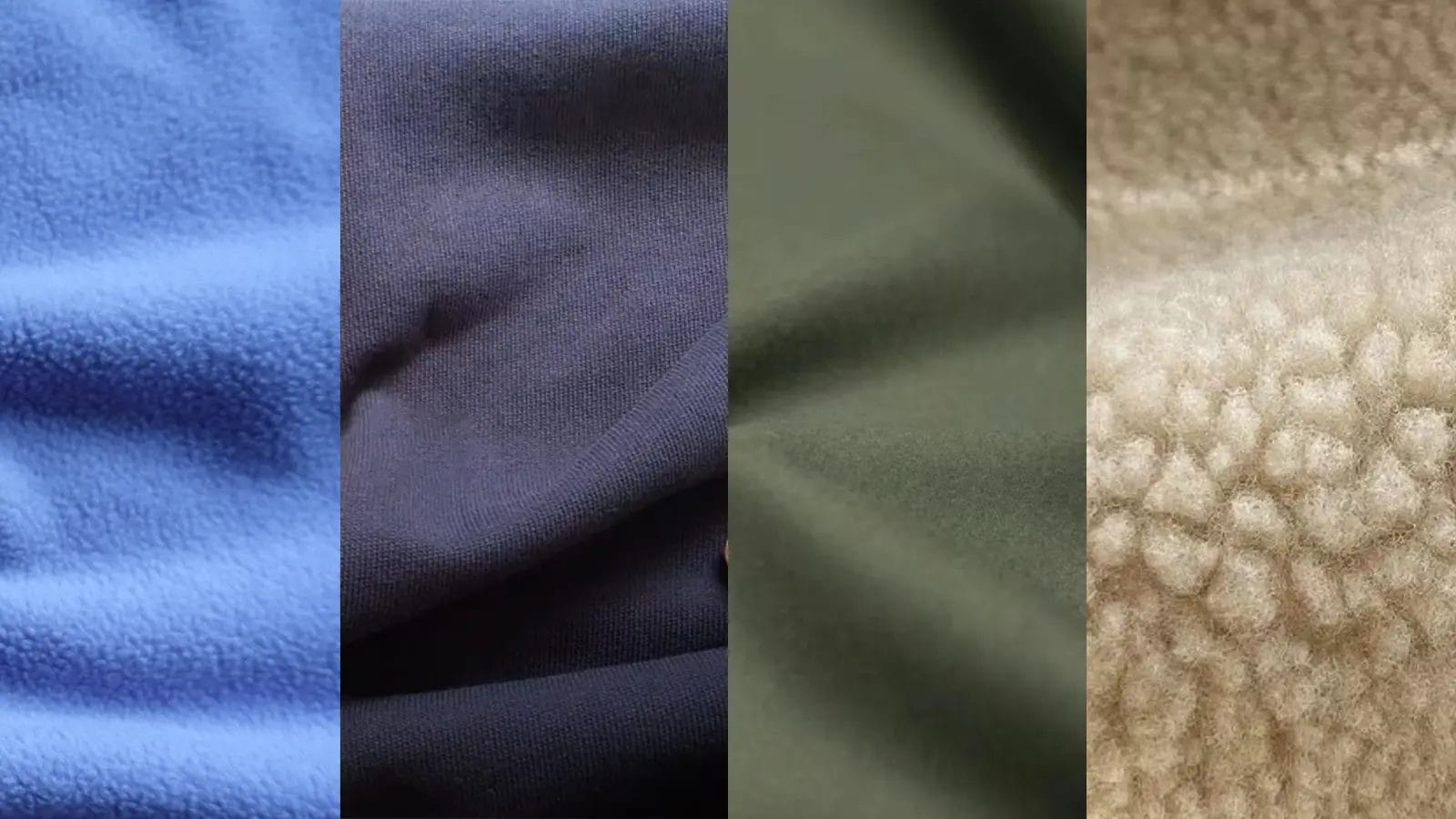
You’ve encountered a variety of fleece types on your embroidery journey. There are differences between each type.
Fabrics such as cotton fleece, polyester fleece, Sherpa, and polar fleece have unique qualities that can improve your embroidery projects.
Understanding these can help you choose the right fleece for your design, ensuring a stunning finish and long-lasting piece.
Cotton Fleece
Cotton fleece stands out as a 100% natural and breathable option for embroidery enthusiasts. This fleece type is soft and absorbs moisture well. It makes your embroidered creations both beautiful and cozy.
Cotton fleece offers a range of weights and textures. It allows for a versatile canvas for your embroidery designs. However, remember to use a stabilizer when you embroider on this fabric. It gives the necessary support and prevents the fabric from stretching during the embroidery process.
You can use different techniques to decorate your cotton fleece garments, fleece blankets, stuffed animals or home decor items.
Polyester Fleece
Polyester fleece is great for embroidering because it’s soft, fuzzy, and stretchy. It is perfect for detailed designs. This plush material is a favorite among embroidery enthusiasts. Quality polyester fleece bounces back when stretched, providing a steady canvas for your needlework.
It’s important to use a cutaway stabilizer when embroidering on polyester fleece. This prevents fabric distortion, ensuring your design remains true to form. If your design is light or delicate, a water-soluble stabilizer can be your best ally. It can be removed easily. This type of stabilizer supports the fabric without leaving a trace once you’re done.
Take advantage of polyester fleece’s properties to create beautiful, personalized pieces.
Sherpa
Sherpa fleece is a popular choice for embroidery because it has a fluffy pile that looks like sheep’s wool.
This soft, warm material is typically made from polyester. It provides excellent insulation for blankets and winter garments. The texture of Sherpa fleece lends itself well to various embroidery designs.
To avoid fabric stretching during embroidery, it’s important to use a cutaway stabilizer because of its fluffy nature. With the right techniques, you can create stunning, professional-looking embroidered designs on this unique and cozy material.
Whether you’re making a warm blanket or personalizing a jacket, Sherpa fleece is a fantastic option.
Polar Fleece
Moving on from Sherpa fleece, let’s explore another popular type. Polar fleece is known for its softness, warmth, and lightweight properties. This synthetic fabric is woven tightly from polyester fibers. It provides a smooth surface that’s ideal for embroidery.
When you’re ready to stitch your design, remember to hoop the fleece to avoid distortion. Selection of stabilizers is crucial too. A cutaway stabilizer is recommended for support, while a water-soluble one can be used for lighter designs.
The right thread will make your embroidery stand out beautifully on polar fleece. When personalizing a jacket or blanket, using the correct techniques and materials will give you professional results.
Tips for Embroidering on Fleece
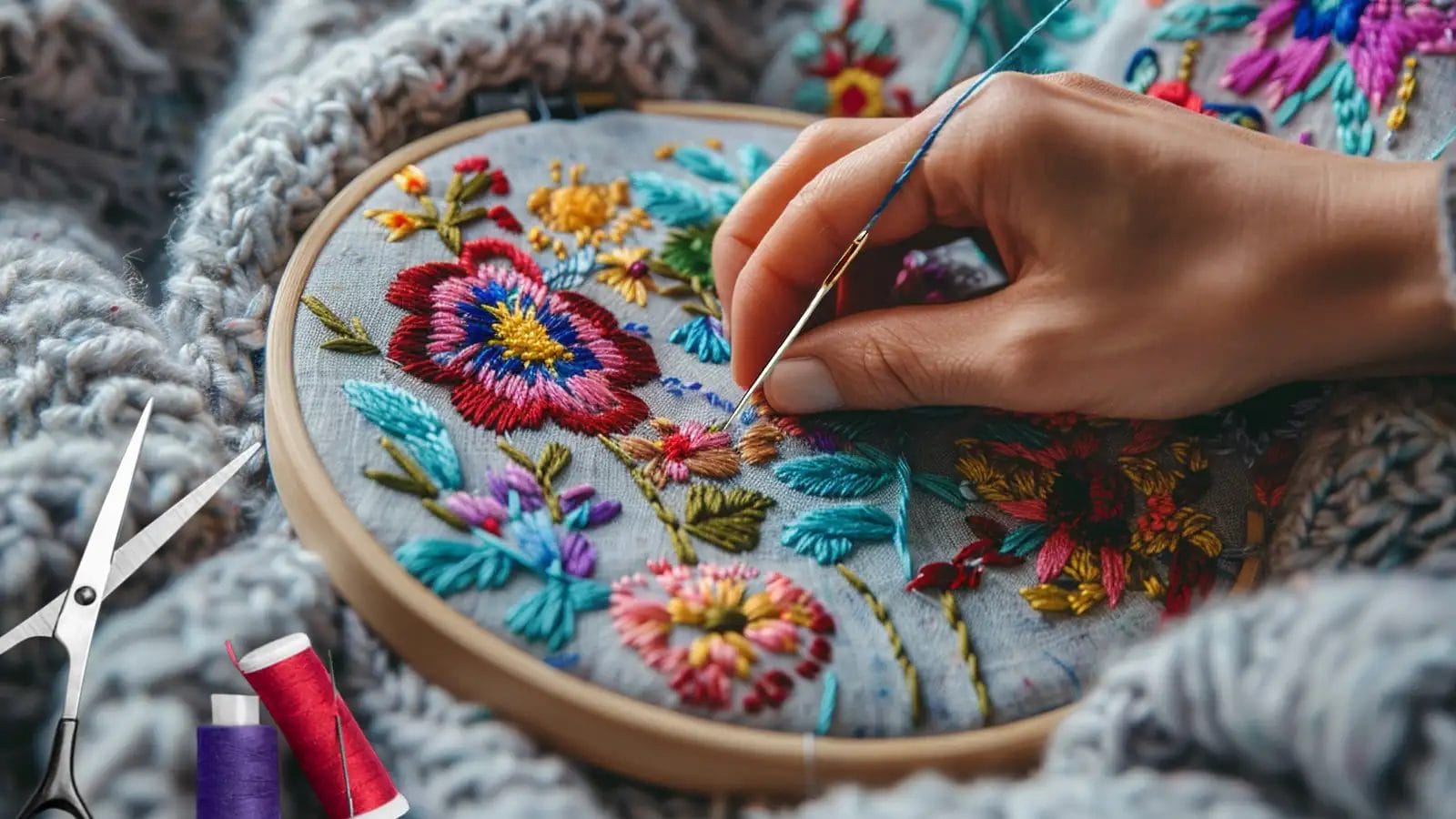
As you embark on the journey of embroidering on fleece, several strategies can help you achieve optimal results. Selecting high-quality fleece will set a strong foundation for your work. Find embroidery designs that do not include thin lines.
To improve your embroidery on fleece, you should know when to use the hooping or floating method. Choose the appropriate stabilizer. Using a knockdown stitch will help your embroidery easier. This will enhance the quality of your embroidery.
Use High Quality Fleece for Embroidery
It’s important to choose premium fleece that can stretch and keep the designs stable. Our top tips include opting for high-quality fleece that’s resilient and durable. This type of material can withstand the pressure exerted by the needle during embroidery.
Choose Embroidery Designs without Thin Lines
It’s also important to carefully consider the type of embroidery designs that will work best on this particular fabric.
Thin lines can get lost in the plush texture of the fleece, making your design less visible. Opt for dense designs with thicker lines, as these tend to display better on fleece. Incorporating satin stitches can also provide better coverage and visibility.
Use Knockdown Stitch for Smoother Stitching
To achieve smoother stitching on your fleece material, consider using the knockdown stitch technique. This method creates a smooth base for embroidery. And it effectively flattens the fleece pile.
The knockdown stitch prevents your embroidery from sinking into the fabric. It also enhances visibility and durability of your design. It’s particularly useful for intricate or detailed designs on fleece, allowing the stitches to lay evenly.
Select Hooping or Floating Method in Fleece Embroidery
Your next step in embroidering on fleece is to decide between two methods: hooping or floating. Hooping is recommended for stable fabrics like fleece as it secures the fabric in place, preventing shifting. Floating are the perfect solution for delicate fabrics. It provides unparalleled protection against hoop marks and distortion. It also provides a gentle and effective solution to your embroidery needs. Each technique affects your embroidery results, so select wisely.
For hooping, ensure the fabric is flat and stable in the hoop. For floating, place the fabric on top of the hoop without stretching. Both methods require a stabilizer.
Choose the Right Stabilizer
Choosing the correct stabilizer is important when embroidering on fleece. It can greatly impact the quality and look of your finished designs.
Cutaway stabilizer is the best option for heavy or dense embroidery designs. It provides strong support to prevent hoop burn and fabric stretching. You might consider using a water-soluble stabilizer on top for lighter designs, to maintain stitch quality. Due to the special nature of fleece, spray adhesive stabilizers are not recommended.
Use a Water-soluble Topper
When embroidering on fleece, use water-soluble toppings. This will prevent stitches from sinking into the fabric. It makes your design crisp and visible.
This lightweight topper is effective in maintaining intricate designs on the plush surface of fleece. As it’s water-soluble, it’ll dissolve easily once you’re done, leaving no extra bulk behind. It can easily wash away, so you can use a water-soluble topper.
It’s an excellent choice for those detailed patterns that risk disappearing into the fleece’s fuzzy texture. A water soluble topping is used to prevent stitches from sinking. It makes embroidery on fleece look professional and clean.
Make sure you use it in your next fleece embroidery project for a top-notch outcome.
Select the Correct Thread for Fleece Project
Choosing the right thread is important for a good fleece embroidery project. The thread impacts the durability, color, and overall appearance of the design. Opt for polyester thread, as it matches the fabric’s composition and ensures durability. Polyester’s colorfastness provides resistance to fading, making your embroidered designs last.
It’s also compatible with fleece’s stretchy nature. It allows your embroidery to move with the fabric without distorting. High-quality polyester thread can prevent breakage and ensure smooth stitching on fleece’s fuzzy surface.
Conclusion
Fleece is one of the popular fabrics in the cold area. It is wonderful to use fleece to make clothes and home decor.
So, you see, embroidering on fleece isn’t as daunting as it may seem. With a keen understanding of different fleece types and handy tips, you’re set to create stunning designs.
Remember, using the right stabilizer and hooping technique is key. Give it a shot and unleash your creativity on your cozy fleece items.
After all, there’s nothing like adding your personal touch to make your items truly unique and special. Happy embroidering!

